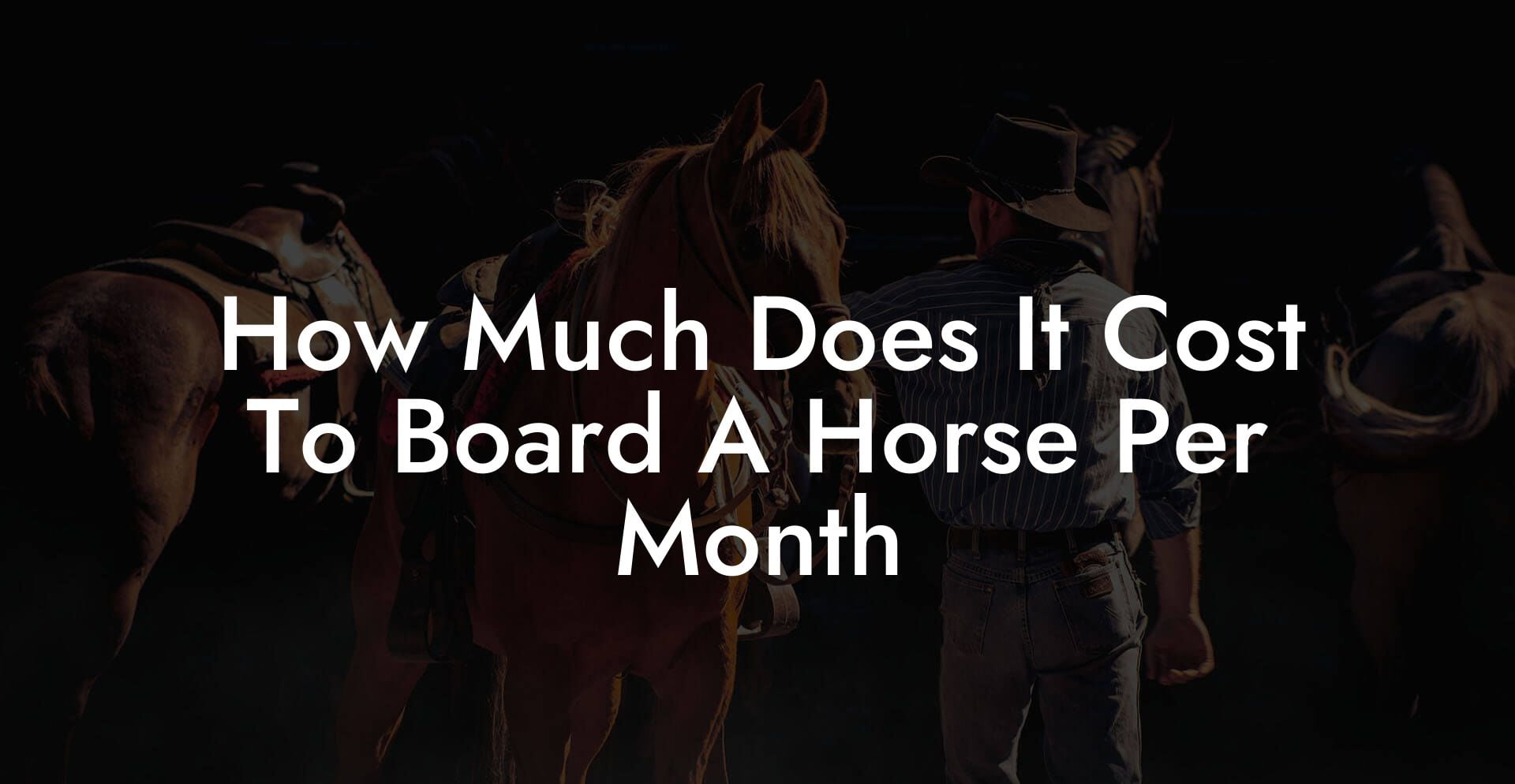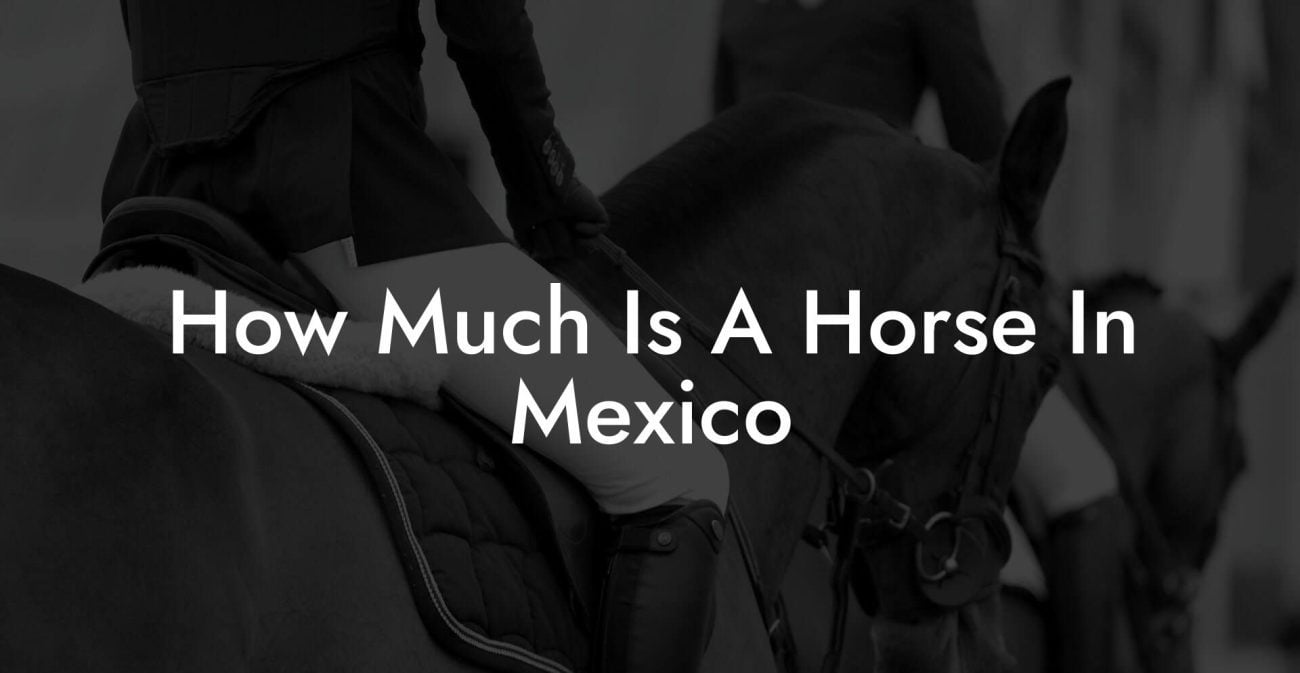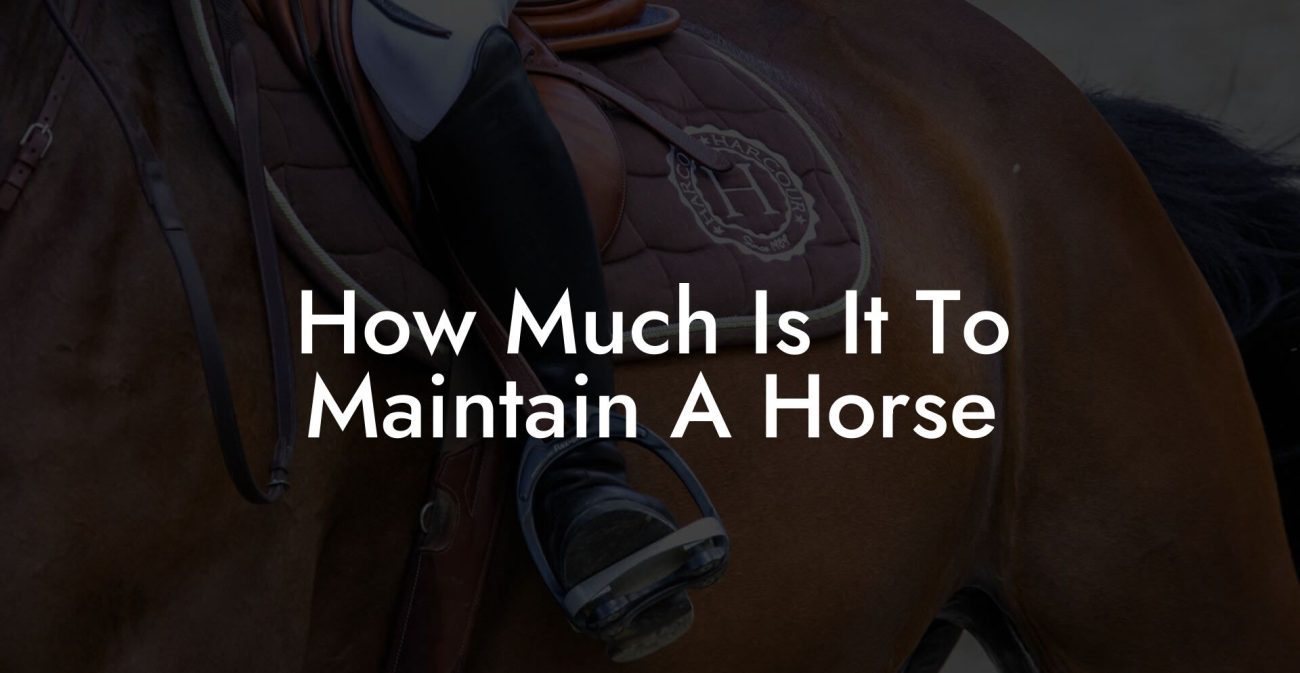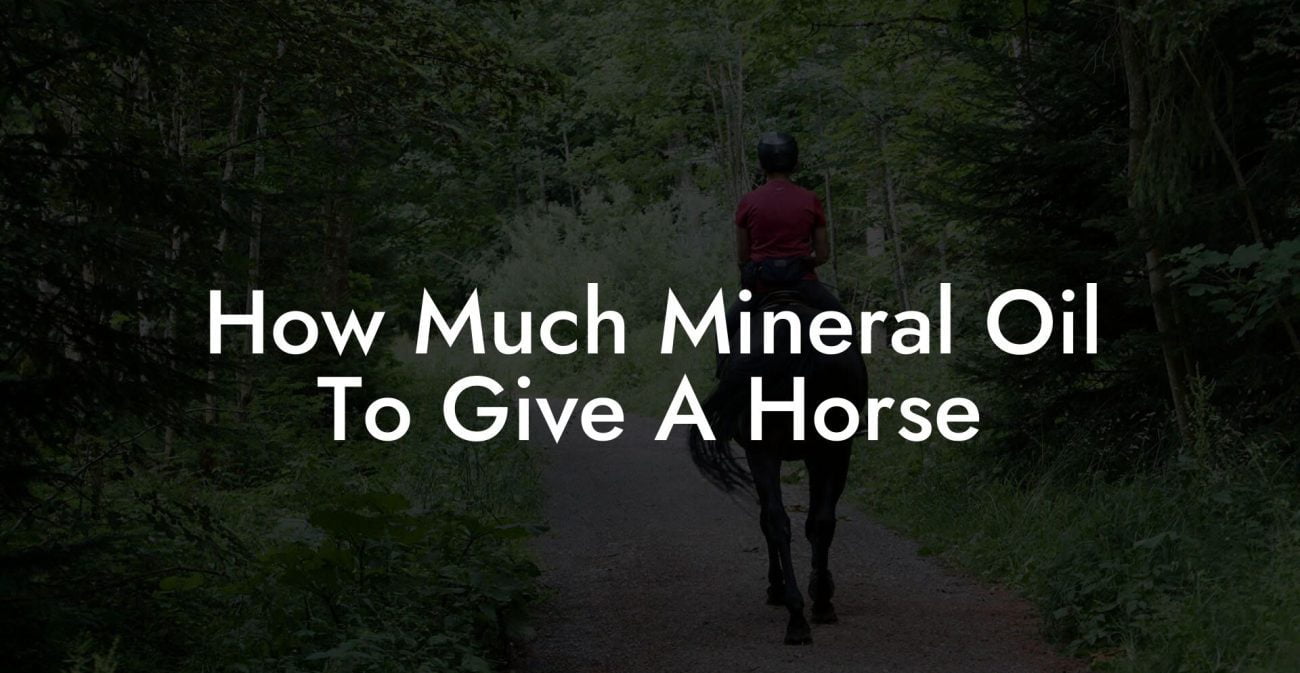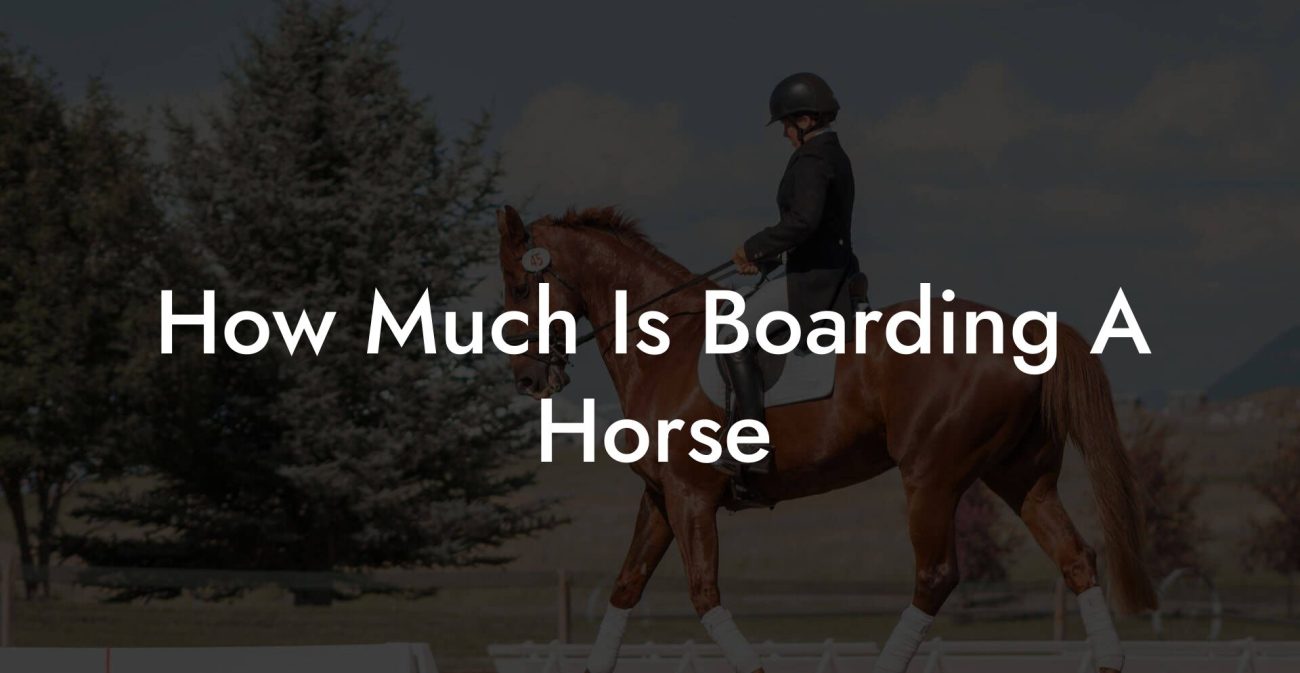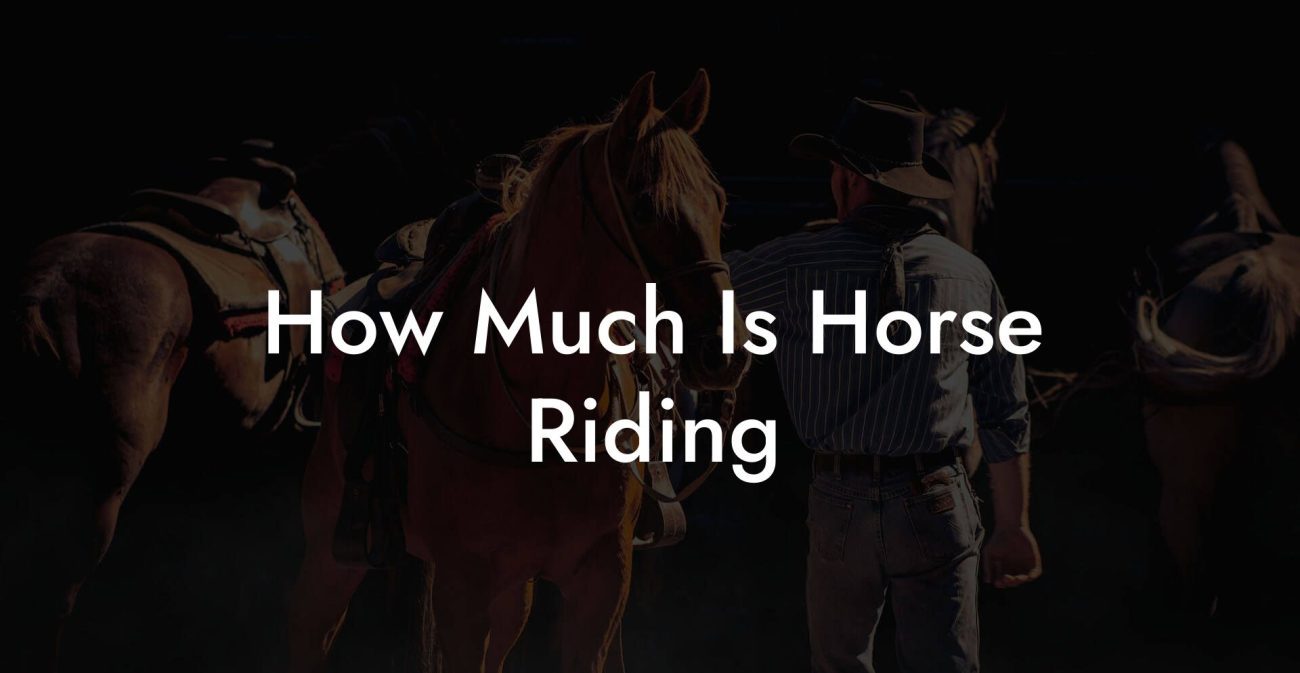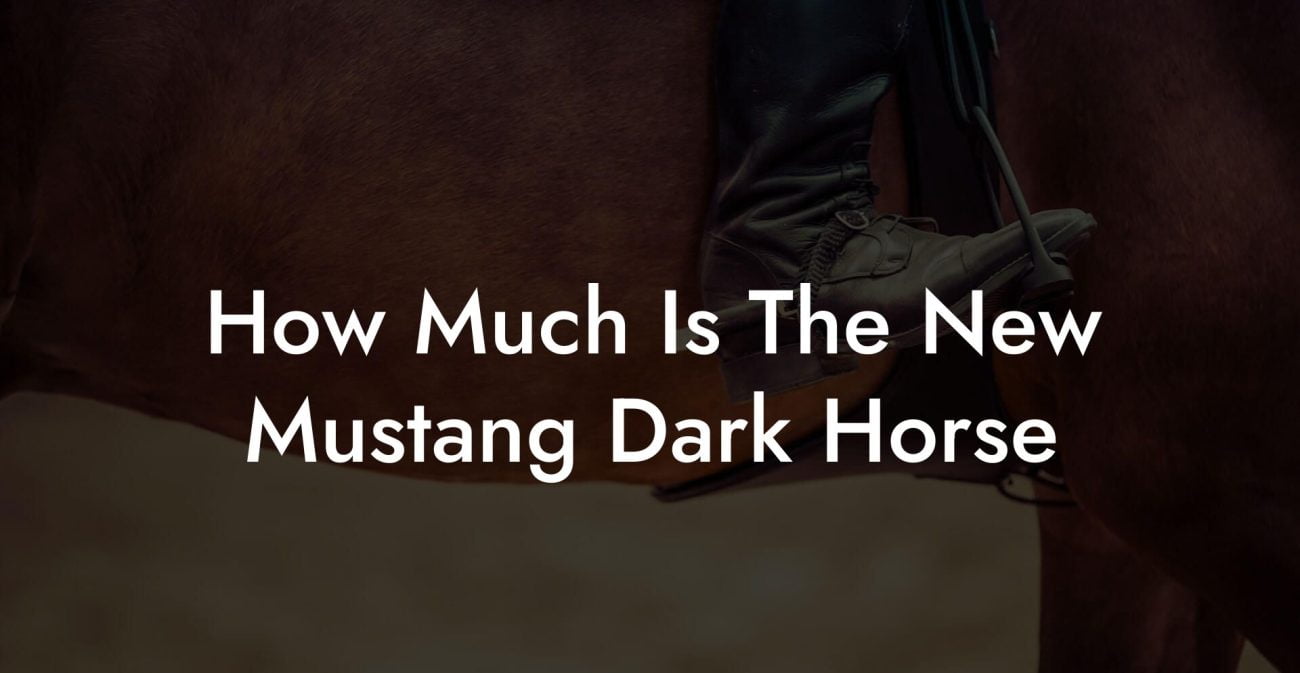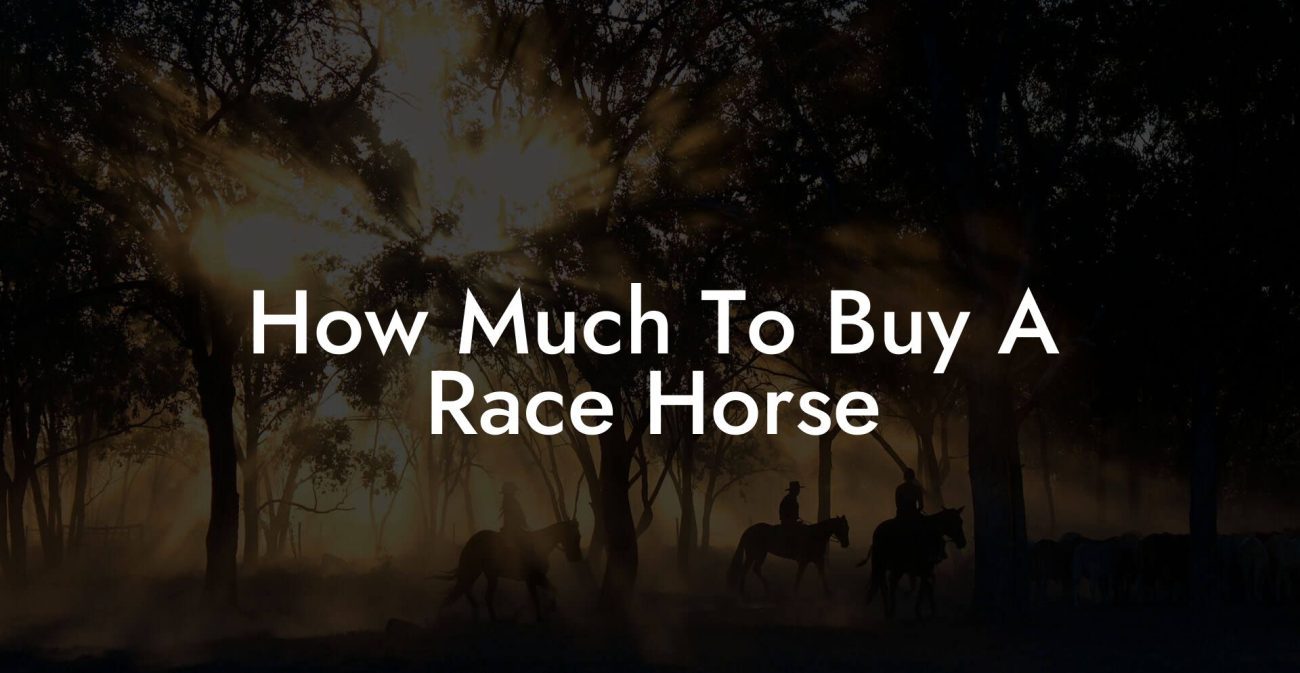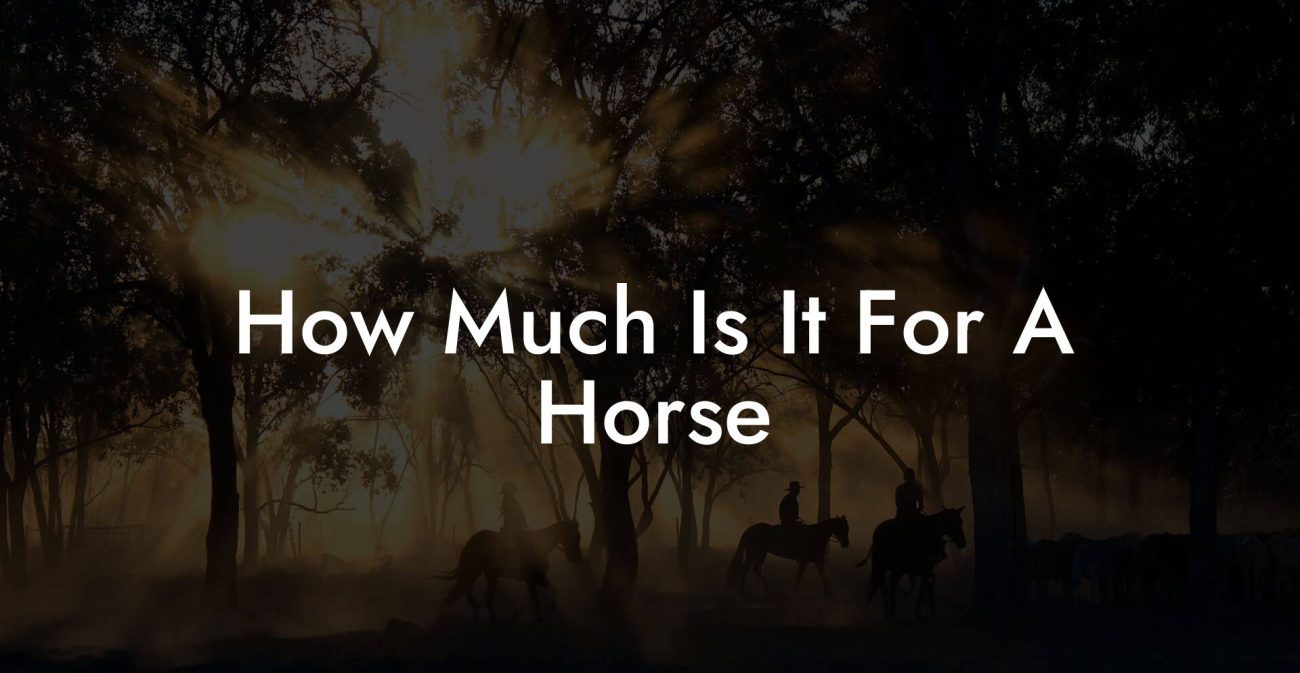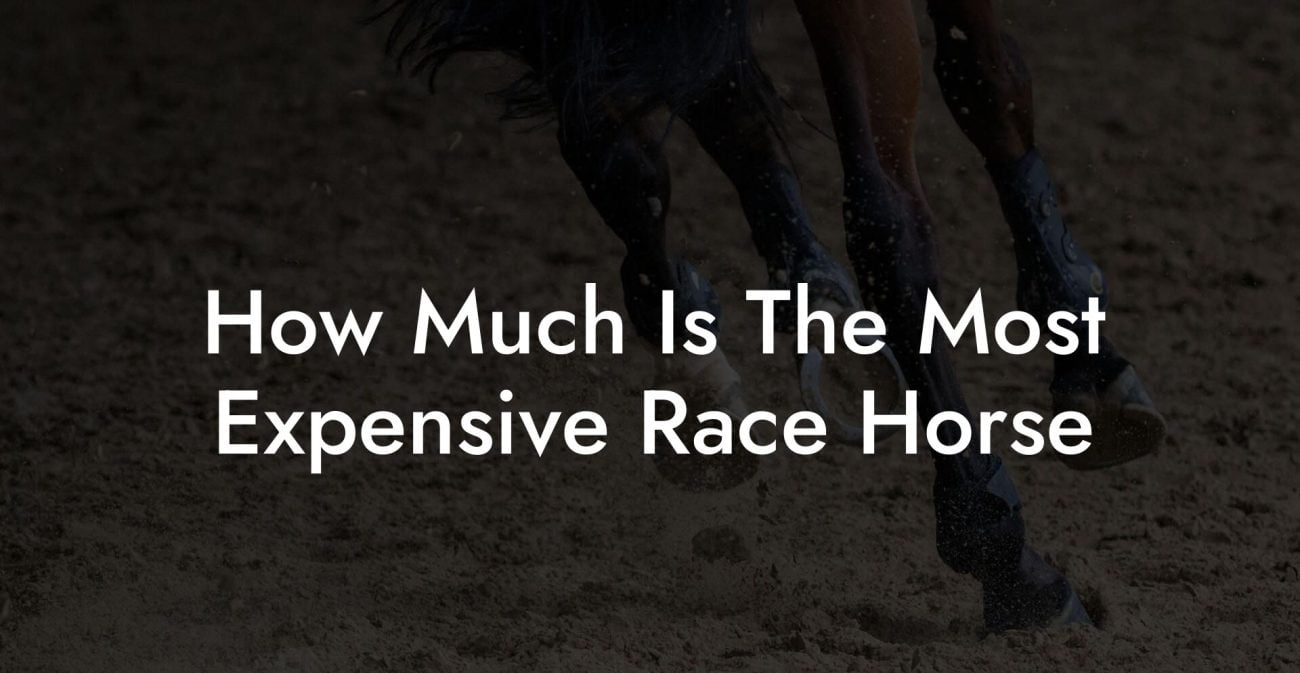Boarding a horse isn’t just about renting a stall, it’s an all-access pass to a vibrant equestrian lifestyle, with hidden costs, unexpected extras, and plenty of opportunities for community connection. If you’re a millennial or Gen-Z rider curious about what it truly costs to board a horse per month, you’re in for a ride. We’re diving into the nitty-gritty details of stable fees, care essentials, and add-on services that transform the boarding experience from a necessary expense into a full-on lifestyle investment.
Quick Links to Useful Sections
- Understanding Horse Boarding: What’s Included?
- Full Board
- Partial or Self-Board
- Semi-Full Board and Specialty Boards
- The Major Cost Drivers in Boarding a Horse
- Location, Location, Location
- Amenities and Infrastructure
- Level of Care and Additional Services
- Stable Size and Community
- Insurance and Maintenance
- Regional Variations: How Geography Affects Boarding Fees
- High-Cost Regions
- Mid-Range and Rural Areas
- International Variations
- Breaking Down the Costs: Where Does Your Money Go?
- Housing and Stall Fees
- Feed and Nutritional Plans
- Labor and Routine Care
- Utilities and Facility Upkeep
- Insurance and Administrative Fees
- Additional Considerations: More Than Just a Stall
- Veterinary and Farrier Expenses
- Training and Lesson Packages
- Horse Insurance
- Boarding Contract Nuances
- Extra Amenities and Perks
- Comparing Boarding Facilities: Tips for Making the Right Choice
- Schedule a Tour
- Ask About Contract Flexibility
- Evaluate the Community Atmosphere
- Consider the Hidden Costs
- Budgeting for Your Horse’s Monthly Boarding Costs
- Create a Detailed Budget
- Explore Payment Plans and Packages
- Consider Group Boarding Options
- Plan for Unexpected Expenses
- Insider Tips for Negotiating Boarding Contracts
- Do Your Homework
- Highlight Your Commitment
- Discuss Long-Term Opportunities
- Be Clear About Your Needs
- Review the Fine Print
- Resources and Community Support: Your Next Steps
- Online Communities, Forums, and Social Media
- Local Equestrian Associations
- Financial Planning and Horse Care Blogs
- Consultations with Boarding Managers
- Equestrian Health and Safety Seminars
- Exploring the Economic Landscape of Boarding: Trends and Future Outlook
- Tech-Enhanced Facilities
- Sustainable Practices
- Economic Shifts and Market Demand
- The Future of Horse Boarding
- Success Stories: Real-Life Experiences in the Boarding World
- The Budget-Savvy Rider
- The High-End Enthusiast
- The Flexible Planner
- Your Journey to Empowered Equestrian Living
- Equestrian Cost FAQs: Your Questions About Boarding Answered
- Your Journey Ahead: Embrace the Equestrian Lifestyle
Understanding Horse Boarding: What’s Included?
When you think about boarding your horse, it’s more than just renting a space, it’s about choosing an environment that fits your equine buddy’s needs and your lifestyle. But what exactly is included in a typical boarding arrangement? Let’s break it down.
Full Board
Full board is the gold standard for those who want a worry-free experience. This often includes a stall or pasture spot, daily turnout, routine feeding (usually hay and grain or supplements), stall cleaning, and sometimes even mucking out. Some full board packages also throw in extras like riding arena access, turnout supervision, and even some basic veterinary oversight. Full board is popular among riders who don’t have time for daily stable chores.
Partial or Self-Board
If you rave about a hands-on approach, many stables offer partial boarding, also known as self-board. In these settings, you rent a stall or a spot in a shared paddock but take care of feeding, mucking, and routine care yourself. The cost here is usually lower than full board, and it’s a hit among riders who relish the stable life and want more control over their horse’s routine.
Semi-Full Board and Specialty Boards
Some facilities also cater to riders with unique needs. Specialty boards provide custom meal plans, scheduled one-on-one training sessions, or even enhanced turnout options. Semi-full board might cover most essentials but leave some tasks to the owner’s discretion. These plans are perfect for those who need a balance between professional care and personal involvement.
The Major Cost Drivers in Boarding a Horse
Boarding a horse isn’t a one-size-fits-all scenario. The monthly cost can vary wildly based on several key factors. Understanding what drives these expenses can help you budget better and find a facility that meets your financial and practical needs.
Location, Location, Location
Just like real estate, the cost of boarding is profoundly affected by where the stable is located. Urban and suburban stables in high-demand areas typically charge premium rates compared to rural stables. Factors such as property taxes, local demand for equestrian services, and the cost of living in that region impact the monthly fees.
Amenities and Infrastructure
The state-of-the-art facilities, modern arenas, well-maintained barns, and top-tier turnout areas drive up costs. If your horse will have access to climate-controlled stalls, automatic waterers, or even web-enabled surveillance systems, be prepared to pay a bit more. Many modern riders appreciate transparency and safety in their boarding environment, so investing in quality amenities is often worth the extra dollars.
Level of Care and Additional Services
Full board packages typically include routine feeding, stall cleaning, and sometimes even exercise sessions. These comprehensive services come at a premium. Some stables further offer daily turnout, farrier visits, and on-call veterinary services in their monthly package, all of which add to the fixed costs.
Stable Size and Community
A larger stable with a thriving equestrian community might charge higher fees due to the social and training opportunities available. Conversely, smaller, family-run facilities might offer more affordable rates, albeit with fewer bells and whistles. Social media-savvy riders often appreciate the networking and riding events small stables provide.
Insurance and Maintenance
Don’t forget that behind every clean stall, there’s a mountain of insurance premiums and maintenance costs. Stables need to maintain equipment, repair damaged structures, and ensure safety in every nook and cranny. These hidden costs often trickle down into your monthly boarding fee.
Regional Variations: How Geography Affects Boarding Fees
You might hear that you can board a horse for as little as a few hundred dollars a month or as much as several thousand. This wide range is largely dictated by region.
High-Cost Regions
In equestrian hotspots like California, New York, and parts of the East Coast, expect higher-than-average fees. Urban demand, land scarcity, and higher operating costs translate to premium prices. Facilities in these areas often offer luxurious amenities that justify the price tag.
Mid-Range and Rural Areas
In suburban or rural landscapes, you’re more likely to find competitive pricing. While these stables might have fewer high-end facilities, they often provide ample space and a more relaxed atmosphere for your horse. Plus, when you factor in the community vibe, a sense of camaraderie among boarders, the value can often outweigh the lower price.
International Variations
If you’re boarding your horse in countries known for their equestrian traditions, like England or Australia, expect different pricing structures. Exchange rates, local customs, and the overall cost of living also influence fees, making international boarding a rich area for comparison.
Breaking Down the Costs: Where Does Your Money Go?
Budgeting for boarding isn’t simply about figuring out the monthly fee, it’s about understanding what you’re paying for. Here’s how the expenses typically break down:
Housing and Stall Fees
The foundation of any boarding cost is the physical space your horse occupies. This fee covers not only the stall or pasture rental but also the upkeep of the facility, cleaning, and maintenance of structures. A pristine stall can cost more, but many owners appreciate the peace of mind knowing their horse is housed in a well-kept environment.
Feed and Nutritional Plans
Depending on your boarding arrangement, feed may be included or billed separately. A full board package often comes with a pre-determined feed plan, ensuring your horse receives quality nutrition without you needing to micromanage. If you’re self-boarding, you might need to budget for hay, grains, supplements, and other dietary items.
Labor and Routine Care
Stable hands, daily cleaning, grooming, and sometimes even riding exercise sessions are factored into your boarding fees. High-quality stables invest in skilled staff dedicated to the well-being of their boarders, meaning you’re indirectly covering wages, training, and more.
Utilities and Facility Upkeep
From water bills for automatic irrigation systems to the cost of lighting in indoor arenas, utilities are a significant, if often overlooked, expense. Maintenance of equipment, buildings, and the grounds prevent decay and ensure a safe environment, contributing steadily to your monthly costs.
Insurance and Administrative Fees
Insurance protects both the facility and you from unexpected mishaps. Regular administrative fees, including booking, security, and management, also play a role in the overall fee structure. A transparent boarding facility will clearly explain these fees during your initial consultation.
Additional Considerations: More Than Just a Stall
While the boarding fee is a major component of your monthly expense, there are additional considerations that riders should keep in mind once they sign on the dotted line.
Veterinary and Farrier Expenses
Regular veterinary care and farrier visits are essential to maintaining your horse’s health. Some boarding facilities include these services in their package, or at least offer them as discounted add-ons. Understanding your board’s policy can help you budget for routine check-ups, emergency care, and hoof maintenance.
Training and Lesson Packages
Many stables offer riding lessons, training sessions, and even speed clinics. While these are optional, they provide fantastic value for riders looking to improve their skills. If you’re budgeting for personal growth in the arena, ask about package deals to get the best rates.
Horse Insurance
Protecting your equine friend with insurance is a wise move. Whether it’s for illness, injury, or even facility-related accidents, having insurance can help manage unexpected costs. Some facilities require proof of insurance as part of your boarding agreement.
Boarding Contract Nuances
Every boarding facility has its own set of rules and contract details. These might include cancellation policies, access times, and even curated boarding schedules. Understanding all the fine print is key to avoiding surprise fees that can impact your monthly budget.
Extra Amenities and Perks
From on-site tack rooms, wash racks, and indoor arenas to community events and riding clinics, many modern stables try to provide a complete equestrian lifestyle package. These extras enhance the boarding experience but can also add to your monthly tab if they aren’t bundled into your standard rate.
Comparing Boarding Facilities: Tips for Making the Right Choice
Choosing a boarding facility is a lot like curating your social feed, it’s all about personal style, quality, and value. Here are some insider tips to help you compare facilities and select one that meets both your budget and your horse care standards.
Schedule a Tour
The best way to get an honest feel for a boarding facility is to visit in person. Schedule a tour to inspect the stables, turnout areas, and amenities. Ask about staff qualifications, emergency protocols, and recent improvements. A facility that prides itself on cleanliness, safety, and community will gladly show off its best features.
Ask About Contract Flexibility
Not all boarding contracts are created equal. Some stables offer month-to-month arrangements, while others require long-term commitments. If you’re new to boarding, look for options that allow flexibility as your needs evolve. Discussions around cancellation policies and fee adjustments can also help avoid future surprises.
Evaluate the Community Atmosphere
Many riders value a community where they can share tips, swap tales, and organize group rides. Ask about the stable’s event calendar, riding clubs, and social media groups. A vibrant community can turn the board into an extended family, greatly enriching the overall experience.
Consider the Hidden Costs
Beyond the monthly fee, ask if there are extra costs for services like prime stall selection, extended turnout periods, or access to specialized training sessions. A breakdown of all potential fees helps create a realistic monthly budget.
Budgeting for Your Horse’s Monthly Boarding Costs
For many young riders and busy professionals, budgeting for horse boarding is a delicate balancing act. Here are some practical tips to manage your finances without sacrificing your horse’s care.
Create a Detailed Budget
Start by listing all recurring expenses, from stall fees to feed costs, insurance, and occasional add-on services. Don’t forget to factor in annual expenses like vaccination clinics or farrier visits that might not show up monthly but still impact your overall budget.
Explore Payment Plans and Packages
Ask if the boarding facility offers discounts for long-term commitments or bundled services. Some stables offer payment plans that allow you to spread out costs evenly over the year, reducing the strain on your monthly cash flow.
Consider Group Boarding Options
Sometimes, sharing a boarding facility with friends or joining a boarding club can help reduce individual expenses. Group discounts or cooperative arrangements allow you to enjoy high-quality care at a fraction of the cost while building lasting connections with fellow riders.
Plan for Unexpected Expenses
Life on the stables isn’t always predictable. Whether it’s an unexpected vet bill or an unplanned upgrade to your horse’s diet, having a contingency fund offers peace of mind. Aim to set aside a small percentage of your boarding fee each month to cover these surprises.
Insider Tips for Negotiating Boarding Contracts
Knowing how to negotiate can help you secure a deal that fits both your needs and your wallet. Here are a few insider strategies to consider when the contract is on the table.
Do Your Homework
Before you step into negotiations, research local boarding rates, the facility’s reputation, and reviews from current boarders. Knowledge is power, and it’s a fantastic conversation starter that shows you’re serious about your horse’s welfare.
Highlight Your Commitment
Facilities value boarders who are committed to the community and actively involved in maintaining the stable’s vibrancy. Explain how you plan to contribute, be it through volunteering at events, organizing group rides, or simply being a dependable presence around the barn.
Discuss Long-Term Opportunities
If you plan to board your horse for a while, mention your desire for a long-term arrangement. Facilities may offer reduced fees for boarders who are signed on for a year or more. Negotiating upfront can lead to significant savings down the line.
Be Clear About Your Needs
Whether you need specific feeding routines, a certain part of the facility for optimal turnout, or flexible access hours, make your requirements known from the start. A facility that values transparency is more likely to work with you to craft a mutually beneficial agreement.
Review the Fine Print
Always read the small print of any contract. Look out for hidden fees, termination clauses, and emergency provisions. If anything seems unclear or one-sided, don’t hesitate to ask for clarification or negotiate adjustments.
Resources and Community Support: Your Next Steps
Boarding your horse is a significant lifestyle decision, but you’re not alone. Numerous resources and communities are available to help you navigate the process with confidence and style.
Online Communities, Forums, and Social Media
Equestrian groups on platforms like Instagram, TikTok, and dedicated online forums offer advice, shared experiences, and even reviews of local stables. Peer recommendations are a treasure trove for insider information that can save you both money and headache.
Local Equestrian Associations
Consider joining local clubs or associations. These organizations often hold events, workshops, and networking opportunities that provide valuable insights into the costs and benefits of various boarding facilities. They’re also a great way to make new friends who share your passion.
Financial Planning and Horse Care Blogs
There’s an abundance of blogs, podcasts, and webinars dedicated to equestrian financial planning. Learning from those who’ve navigated the financial maze of horse care can empower you to manage your budget more effectively. Look for blogs that speak your language, fresh, relatable, and full of real-life examples.
Consultations with Boarding Managers
Most reputable stables offer consultations, sometimes free of charge, where you can discuss your horse’s needs, your budget, and any questions about the facility. Take advantage of these sessions to get detailed answers tailored to your situation.
Equestrian Health and Safety Seminars
Some stables organize seminars on topics ranging from everyday horse care to emergency preparedness. These seminars offer practical tips on maintaining your horse’s health, understanding insurance requirements, and even learning negotiation tactics for better boarding contracts.
Integrating these resources into your decision-making process will not only help you secure the best boarding setup for your horse but also connect you with a larger community of like-minded riders. Your journey in the equestrian world is just beginning, arm yourself with information, lean on your network, and ride with confidence.
Exploring the Economic Landscape of Boarding: Trends and Future Outlook
The world of equestrian boarding is continuously evolving, thanks in part to technological advancements, shifting demographics, and evolving rider expectations. For Gen-Z and millennial riders, innovation and sustainability are more than buzzwords, they’re essential aspects of a modern boarding facility.
Tech-Enhanced Facilities
New-age stables are embracing technology like never before. Mobile apps for tracking your horse’s health, online portals for schedule updates, and even smart monitoring systems in the stables are slowly changing the face of boarding. These tech enhancements not only make life easier but can also drive up the boarding fee due to improved service quality.
Sustainable Practices
As the environmental consciousness of riders grows, many facilities are incorporating green practices. Solar-powered barns, eco-friendly waste management, and sustainable feeding practices are gaining popularity. Although the initial costs might be higher, the long-term savings and the knowledge that you’re supporting a sustainable operation can be well worth the investment.
Economic Shifts and Market Demand
The equestrian market is subject to broader economic trends. In times of economic boom, luxury boarding and specialized amenities flourish. Conversely, economic downturns tend to drive demand for cost-effective, no-frills boarding solutions. Staying informed about these trends can help you time your decision to board a horse based on market conditions.
The Future of Horse Boarding
Looking ahead, expect a continued blurring of lines between traditional boarding and a full-service equestrian lifestyle. Facilities may increasingly offer a la carte services, allowing owners to customize their boarding package, from basic housing to spa-like treatments for horses. For riders who prize flexibility and personalization, the future of boarding is looking as dynamic as the equestrian community itself.
Success Stories: Real-Life Experiences in the Boarding World
Real-life success stories from horse owners and boarders serve as tangible proof that the right boarding facility can transform not only your horse’s life but your whole riding experience. Let’s dive into a few inspiring anecdotes.
The Budget-Savvy Rider
Jessica, a passionate rider balancing a freelance career and a love for all things equine, discovered a suburban stable offering self-board services at an affordable rate. Despite living on a budget, Jessica managed to create a thriving routine where she handled her horse’s feeding, grooming, and exercise. With smart budgeting and a touch of creativity, she even negotiated discounts for impromptu training sessions and found herself becoming a beloved part of the stable community.
The High-End Enthusiast
On the flip side, Mark, a young professional with a taste for luxury, chose a state-of-the-art full board facility in an urban area. Although the monthly fees were on the higher end, Mark valued the comprehensive care, modern amenities, and the bustling equestrian networking events that came with it. His board not only provided routine care but also introduced him to opportunities for competitive riding and advanced training.
The Flexible Planner
Then there was Sarah, who opted for a semi-full board and loved the freedom it offered. With the option to manage part of her horse’s care herself, she was able to balance the financial aspects while still relying on professional upkeep for the heavy-duty tasks. Her story is one of versatility, showing that with research and negotiation, there are board options for every kind of rider.
These stories are testament to the fact that no matter your budget or boarding style, there’s a solution out there that can meet your horse’s needs while aligning with your personal and financial goals.
Your Journey to Empowered Equestrian Living
Boarding a horse isn’t just a monthly expense, it’s an investment in your lifestyle, your passion for riding, and the well-being of a majestic animal that becomes part of your family. With a clear understanding of what influences the boarding costs, from location to amenities to the level of care provided, you’re better equipped to choose the right facility that meets your needs and your budget.
Whether you value the personal touch of self-boarding or the convenience of a full board arrangement, each option offers unique perks that contribute to a fulfilling equestrian experience. Embrace the process of researching, touring, and negotiating with a creative spirit and remember that your horse’s home should be just as vibrant and dynamic as you are.
As you build your equestrian adventure, one that blends financial savvy with community spirit and a love for the ride, know that every dollar spent on quality boarding is also an investment in long-term health, happiness, and endless riding memories. The journey is as rich as the destination, and with the proper planning, both you and your horse can gallop confidently towards the horizon.
Equestrian Cost FAQs: Your Questions About Boarding Answered
We know that the financial side of horse boarding can feel as complex as a dressage routine. Here are some frequently asked questions that break down the costs and provide clarity for riders at all levels:
1. How much does it typically cost to board a horse per month?
The cost to board a horse per month varies dramatically based on location, level of care, and services included. On average, expect to pay anywhere from $300 to over $1,500 a month.
2. What is included in a full board package?
Full board usually includes stall or pasture rent, feeding, daily turnout, stall cleaning, and sometimes extras like riding arena access and routine farrier care.
3. How can I reduce my monthly boarding costs?
Consider self-board or partial board options, join a boarding club for group discounts, and negotiate flexible contracts that allow you to add services only when needed.
4. Do facilities charge extra for additional services like training or advanced nutrition?
Yes, many stables offer optional add-ons such as training sessions, specialized feeding plans, or health check-ups that come at an additional cost.
5. How do regional differences affect boarding costs?
Urban areas and equestrian hotspots often charge premium rates due to higher operating expenses and demand, while rural facilities may offer more competitive pricing.
6. Is it possible to negotiate boarding fees?
Absolutely. Many facilities are open to negotiating rate adjustments, especially if you commit to a long-term contract or bundle services. Understanding the overall cost breakdown is crucial during these discussions.
7. What additional costs should I be aware of beyond the monthly fee?
Besides the basic boarding fee, you might incur extra charges for veterinary care, farrier visits, training sessions, and unforeseen service fees as outlined in the contract.
8. Where can I find reliable reviews and testimonials about boarding facilities?
Online equestrian forums, social media groups, and local equestrian associations provide honest insights and reviews from current boarders.
These FAQs aim to clarify your concerns about boarding costs, providing a comprehensive look at budgeting for an equine lifestyle.
Your Journey Ahead: Embrace the Equestrian Lifestyle
Boarding your horse marks the beginning of an exciting, enriching chapter that marries passion with practicality. The financial commitment might seem daunting at first, but with careful planning, research, and some savvy negotiation, you’ll find that the right stable can offer more than just a place for your horse to sleep, it can become a vibrant hub of community, wellness, and growth.
From understanding the fundamental differences between full board, partial board, and specialty board, to dissecting the myriad of cost factors from amenities to labor, you’ve now been equipped with the tools to make an informed decision. Every dollar spent is a vote for quality care, a nod to sustainability, and a promise of a better life for your equine companion.
So, if you’re ready to crank up your equestrian journey, take this guide as your roadmap. Dive into stable tours, connect with local communities, and embrace the very real possibility that with creativity and diligence, you can secure a boarding facility that caters to both your budget and your lifestyle. Your horse, and your future self, will be all the richer for it.
Whether your dream is to ride endless trails, join group competitions, or simply enjoy the everyday pleasures of a well-cared-for horse, the door to elite boarding is wide open. Take that first step, be confident in your choices, and remember: a thriving equestrian lifestyle is about more than cost, it’s about connection, community, and living your passion every single day.

